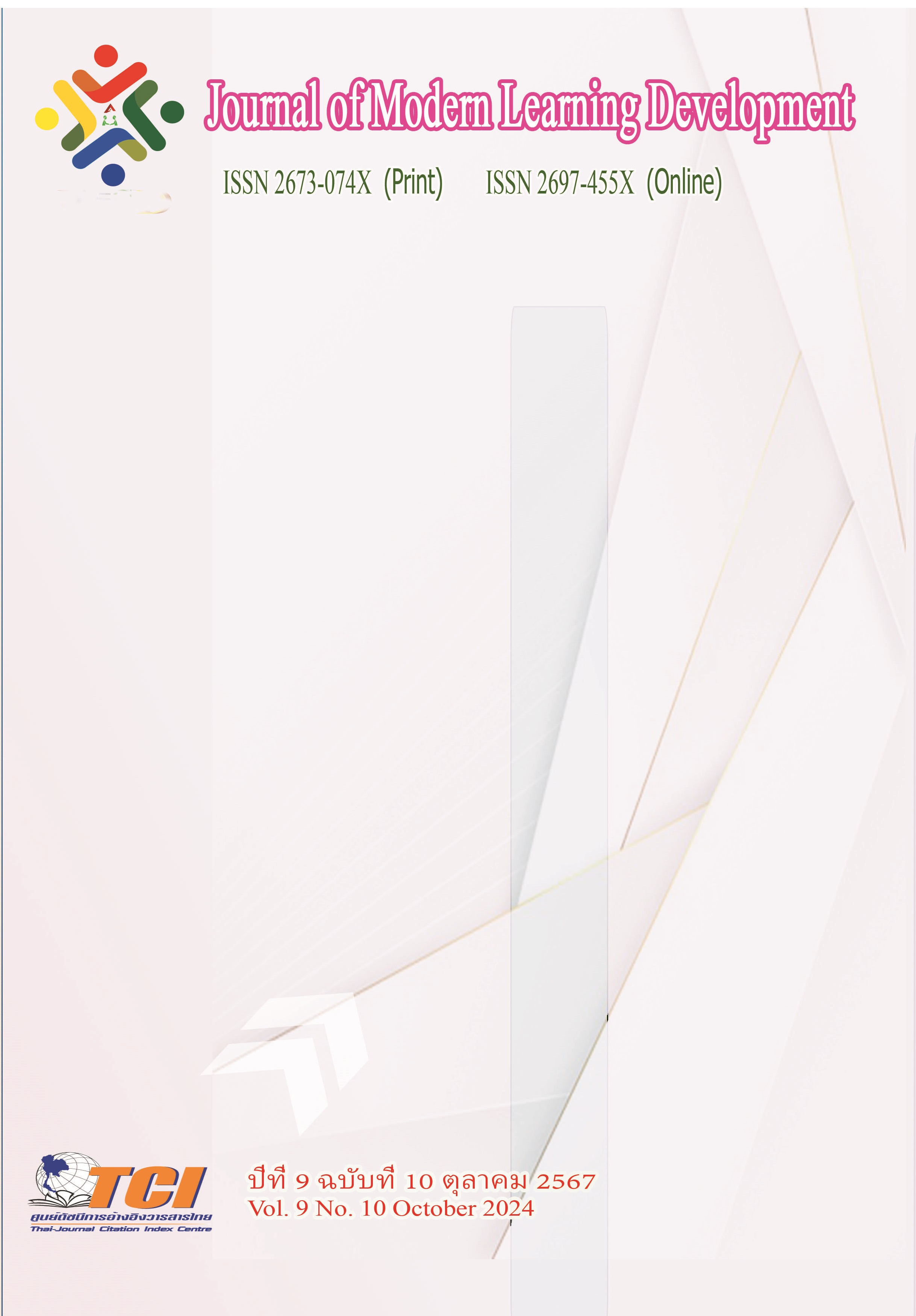The Influence of E-commerce Live Streaming on Consumers' Irrational Consumption Behavior:A Case of Changsha City, China
Main Article Content
Abstract
Irrational consumption behavior is an important part of human consumption activities. In recent years, e-commerce live streaming has developed rapidly in China. Some consumption behaviors of Chinese consumers have shifted from offline or traditional e-commerce to e-commerce live streaming, and irrational consumption behaviors have also migrated to e-commerce live streaming. Based on previous studies, the objectives of this study are: 1) To study the components of e-commerce live streaming that influence consumers' irrational consumption behavior; 2) To clarify the correlation between e-commerce anchors' attributes, sellers' characteristics, consumers' shopping status and irrational consumption behavior; 3) To analyze the mediating role of consumer trust in e-commerce live streaming and irrational consumer behavior; 4) To identify the biggest factors of e-commerce live streaming that influence consumers' irrational consumer behavior according to the degree of their role. Using the snowball sampling method, 425 valid samples were collected. Descriptive statistical analysis and confirmatory factor analysis were performed on the sample data to test reliability and validity, and a structural equation model was constructed to verify the research hypothesis.
The research results show that: 1) the factors that affect consumers' irrational consumption behavior through e-commerce live streaming include e-commerce anchor attributes, e-commerce seller characteristics, consumer shopping status and consumer trust; 2) e-commerce anchor attributes, e-commerce seller characteristics and consumer shopping status significantly affect consumers' irrational consumption behavior; 3) consumer trust plays a mediating role between e-commerce live streaming and irrational consumption behavior; 4) consumer shopping status is the most important factor affecting consumers' irrational consumption behavior. It is recommended to enhance the attributes of e-commerce anchors, improve the integrity of e-commerce sellers, and advocate rational consumption by consumers.
Article Details
References
Adelaar,T.,Chang,S.,&Lancendorfer,K.M. (2003). Effects of media formats on emotionsand impulse buying intent. Journal of Information Technology, 18 (4), 247-266.
Bearden,W.O.,Netemeyer,R.G.,&Teel,J.E. (1989). Measurement of consumer susceptibility to interpersonal influence. Journal of Consumer Research,15,473-481.
Beatty,S.E.,&Ferrell,M.E. (1998). Impulse Buying:Modeling its recursors. Journal of Retailing, 74 (2), 169-191.
Borges, A., Chebat, J. C., & Babin, B. J. (2010). Does a companion always enhance the shopping experience?. Journal of Retailing and Consumer Services, 17 (4), 294-299.
Chang,K.C. (2013). How Reputation Creates Loyalty in the Restaurant Sector.International Journal of Contemporary Hospitality Management, 25 (4), 536-557.
Cheng,H.N.,Huang,Y.T.,Huang,J.S. (2022). The Application of DEMATEL-ANP in Livestream E-Commerce Based on the Research of Consumers’ Shopping Motivati on. Scientific Programming, 2, 1-15.
CNNIC. (2023). The 52th Statistical Report on Internet Development in China. Online. Retrieved August 30, 2023, from https://www.cnnic.cn/n4/2023/0828/c88-10829.html
Cochran, W. G. (1953). Matching in analytical studies. American Journal of Public Health and the Nations Health, 43 (6), 684-691.
Ding, M. L.. (2018). Research on the influence of consumer purchase behavior under the model of "Netflix + Live Streaming + E-commerce". China Market, 16, 148-149.
Dholakia,U.M. (2000). Temptation and resistance: an integrated model of consumption impulse formation and enactment. Psychology&Marketing. 17 (11), 955-982.
Fei, H.P.,&Zhou, C.C. (2021). Host types and brand attitudes and purchase intentions--an experimental study based on webcast shopping scenarios. Journal of Henan Normal University (Philosophy and Social Science Edition), 48 (3), 80-89.
Han,X.Y.,&Xu,Z.L. (2020). The influence of e-commerce anchor attributes on consumers' willingness to purchase online - A study based on the rooting theory approach. Foreign Economics and Management, 42 (10), 62-75.
Kahneman,D. (2003). Maps of Bounded Rationality: Psychology for Behavioral Economics. American Economic Review, 93, 1449-75.
Kollat,D.T.,&Willet,R.P. (1969). Is impulse purchasing really auseful concept for marketing decision?.Journal of Marketing, 33 (5), 21-31.
Kotler,P. (2000). Marketing Management. New Jersey: Prentice HalL.
Lee,J.E.,&Watkins,B. (2016). YouTube vloggers’ influence on consumer luxury brand perceptions and intentions.J.Bus.Res, 69, 5753-5760.
Li,H.,Jiang,J.h.,&Wu,M.j. (2014). The effects of trust assurances on consumers’ initial online trust: a two-stage decision-making process perspective. Int. J. Inf.Manag, 34 (3), 395-405.
Liu,F.J.,Meng,L.,Chen,S.Y.,&Duan,K. (2020). A study on the impact of Netflix live streaming on consumers' purchase intention and its mechanism. Journal of Management, 17 (1), 94-104.
Luo,X.M. (2005). How Does Shopping With Others Influence Impulsive Purchasing?. Journal of Consumer Psychology, 15 (4), 288-294.
Ma,Y.B.,&Chao,G.L. (2011). The impact of peer's consistent evaluation on individual consumption hedonic experience - A perspective based on the asymmetry of peer influence in the process of joint consumption of hedonic products. Modern Management Science, 3, 23-24+63.
Mavlanova, T., Benbunan-Fich, R, &Lang, G. (2016). The Role of Extemal and Intermai Signals in E-commerce.Decision Support Systems, 100 (88), 59-68.
Meng,L.,Liu,F.J.,&Chen,S.Y. (2020). Can I arouse you–A study on the mechanism of the influence of different types of live weblebrity information source characteristics on consumers’ purchase intention. Nankai Manag. Rev, 23, 131-143.
Meng,L.,Duan,S.,Zhao,Y.,Lü,K.,&Chen,S. (2021). The impact of online celebrity in live streaming E-commerce on purchase intention from the perspective of emotional contagion.J.Retail.Consumer Serv. 63, 102733.
Ohanian,R. (1990). Construction and validation of a scale to measure celebrity endorsers’ perceived expertise,trustworthiness,and attractiveness. Journal of Advertising, 19 (3), 39-52.
Palvia,P. (2009). The role of trust in e-commerce relational exhange: A unified model. Information&Management, 46, 213-220.
Rook,D.W.,&Hoch,S.J. (1985). Consuming impulses. Advances in Consumer Research, 12 (3), 23-27.
Soderlund,M.,Oikarinen,E.L.,&Tan,T.M. (2021). The happy virtual agent and its impact on thehuman customer in the service encounter.J.Retail.Consumer Serv. 59, 102401.
Stern,H. (1962). The Significance of Impulse Buying Today. Journal of Marketing. 26, 59-62.
Tibert,V.,&Willemijin,V.D. (2011). The infiuence of online store beliefs on consumer onlineim pulse buying:a model and enpirical application. Information & Management,
(8), 320-327.
Yang,K.,&Yang,W. (2017). "Webcasting+":A new model of brand marketing under the influence of mobile Internet. Publishing Wide Angle, 10, 65-67.


